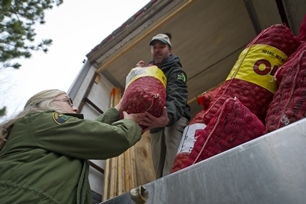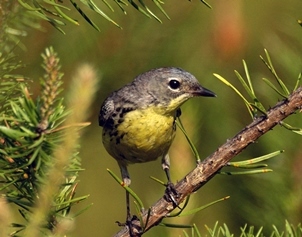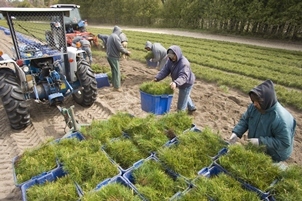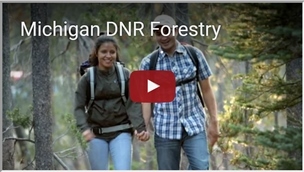Regenerating state forests takes planning, patience
You’re driving on your favorite stretch of Michigan road. The sun is shining, the windows are rolled down, and you’re singing along to that catchy song drifting out of the speakers. As you round a familiar curve in the road, you know you’re approaching a special place, near the campground your family used to frequent when you were a kid.
 You turn your gaze to the left to take in the sight of that beloved stand of trees you’ve admired for years. When you see it, your eyes go wide and your foot jerks away from the gas pedal to the brakes. You turn your gaze to the left to take in the sight of that beloved stand of trees you’ve admired for years. When you see it, your eyes go wide and your foot jerks away from the gas pedal to the brakes.
The space where your cherished gentle giants once stood is now bare. Branches, logs and other debris are strewn around an opening where aspen once grew tall. A few individual trees remain, looking small and sad amid the ruin.
Your treasured forest land has been clear-cut.
OK, maybe this is a slightly dramatic example, but if you ask Bill O’Neill – Michigan’s state forester – about clear-cuts, the first thing he’ll tell you is this: “They’re ugly.”
“There’s no sugar-coating it, clear-cuts aren’t pretty,” said O’Neill, who also serves as chief of the Forest Resources Division in the Michigan Department of Natural Resources.
“We understand that folks don’t like seeing harvesting, especially near the places that served as the backdrop for the camping trips and hunting seasons of their memories,” he said. “But it’s important to remember that any activity that takes place on state-managed forest land is driven by science and by what is, in the long term, best for the resource. Clear-cutting is an essential and proven forest management tool.
“We know it’s hard to believe. Just because a recently harvested area is unsightly now, that it doesn’t mean it will be ugly forever. In fact, that area grows back even faster than you’d probably believe,” O’Neill said.
 Forest regeneration is the practice of establishing young trees after the previous stand has been removed. It is part of a process that begins with planning and coordinating timber harvests, and is just another part of a DNR forester’s day-to-day job – they’re planning the makeup of the new forest long before a single tree is cut. Forest regeneration is the practice of establishing young trees after the previous stand has been removed. It is part of a process that begins with planning and coordinating timber harvests, and is just another part of a DNR forester’s day-to-day job – they’re planning the makeup of the new forest long before a single tree is cut.
“We can plan the type of timber harvest so the harvest itself is the tool to regenerate. We use artificial regeneration as a supplement,” said Jason Hartman, a DNR silviculturalist. A silviculturalist is responsible for the development and care of the trees in a forest.
A majority of state forest land regrows quickly after a thinning or clear-cut. Some species begin to regenerate within a year after a timber harvest, Hartman said. “It just depends on the type of tree. Clear-cuts are the best way to regenerate species that need a lot of sunlight, like aspen or jack pine. Aspen regrows quickly because the young trees sprout using the existing root system from the previous stand.
“But some species don’t regenerate well on their own,” Hartman said. “Poor soil, dry weather and competition from other vegetation all come into play when the forest needs a little help building itself back up.”
 Scarification is one of the tools the DNR uses to promote natural regeneration. Usually, scarification works best for jack pine trees growing in sandy soil. Scarification is one of the tools the DNR uses to promote natural regeneration. Usually, scarification works best for jack pine trees growing in sandy soil.
Scarification involves dragging large metal anchor chains through the material leftover after a timber harvest — also known as slash. The anchor churns up the slash and mixes the seed cones with the soil. When the ground temperature reaches approximately 100 degrees, the cones pop open and release the seeds.
“It’s a very efficient way to regenerate the forest,” said Don Kuhr, DNR timber management specialist. “Basically, with scarification, we’re just mimicking what Mother Nature does with fire.”
If the conditions aren’t quite right for scarification, the DNR will plant new trees. Every year, between 5 million and 7 million seedlings are planted by hand on 3,000 to 4,000 acres of state forest land. Each member in a planting crew can plant between 4,000 and 5,000 trees in a single day.
Most often, the DNR plants jack and red pine, usually in the northern Lower Peninsula and the eastern Upper Peninsula. The seedlings are grown at the DNR’s Wyman Nursery in Manistique, from seeds collected by local residents.
Once seedlings are planted, the DNR monitors the young trees’ progress to make certain the stands are getting what they need to mature into a healthy forest. That monitoring and evaluation continue through every timber sale, whether the trees were planted or regenerated naturally.
“We do surveys one year and three years after planting, and we’ll replant the stands as needed,” Hartman said.
 These regenerated stands then become ideal homes for many species of wildlife. Deer, elk, grouse, black bears, beavers, rabbits and even songbirds love young stands because they provide food and shelter. These regenerated stands then become ideal homes for many species of wildlife. Deer, elk, grouse, black bears, beavers, rabbits and even songbirds love young stands because they provide food and shelter.
“Wild animals use different forest types at different times of the year, and timber sales allow us to provide food for more than just the fall when everyone is thinking about acorns,” DNR Wildlife Division field operations manager Brian Mastenbrook said.
“We need to be thinking about other months of the year,” he said. “For example, young regenerating trees are a great winter and early spring food source for deer, available above the snow line when nothing else is green.”
People benefit from forest regeneration, too. Forests that are diverse in age are less susceptible to forest pests, diseases and wind and fire damage. That’s important from a recreation standpoint, because healthy forests are a big draw for Michigan residents and visitors who like to spend time outdoors. These green spaces appeal to hunters and campers, wildlife watchers, hikers and others interested in unplugging from their traditionally wired lives.
Gabe Schneider loves the Traverse Area Recreation and Transport (TART) Trails for just that reason. As a TART Trails Ambassador, avid skier and cyclist, Schneider has come across his fair share of forest management activities – things not always to his liking. He confessed he used to be skeptical of proposed management activities, but his perspective recently changed due to the DNR’s increased efforts to engage users.
 “Not only has the DNR provided greater opportunity for input and education before decisions are made, but they also have worked with the forest products company to ensure better on the ground maintenance of conditions, including regrading access roads to ensure smoother, less rutted trail crossings,” Schneider said. “Not only has the DNR provided greater opportunity for input and education before decisions are made, but they also have worked with the forest products company to ensure better on the ground maintenance of conditions, including regrading access roads to ensure smoother, less rutted trail crossings,” Schneider said.
Residents, park and trail users, hunters, and anyone else who’s interested are invited to attend public open houses and compartment review meetings to discuss plans for the forest.
“I not only have a better understanding of the importance of these operations on overall forest health, but I also have had a better user experience because of the DNR’s active involvement of trail users in the decision-making process,” Schneider said.
O’Neill said there’s also a pretty compelling economic upside to sustainable, regenerated forests.
“Every year, Michigan’s forest products industry brings in roughly $20 billion to the state’s economy, and it provides jobs for some 90,000 people,” he said. “And when you’re talking about the Upper Peninsula, that impact is huge. Of all the U.P.-based manufacturing jobs, more than a third of those are tied to forest products.”
That trend shows no signs of slowing down, as Michigan’s sustainable forests continue to attract new businesses.
One example is Arauco North America’s new particle board plant – a $325 million investment – under construction right now in Grayling (Crawford County). The company anticipates the project will add 250 jobs to the area.
“Businesses like Arauco and Weyerhaeuser came to Michigan because they saw we were investing in the forest through regeneration,” Hartman said. “There’s a future product out there for them.”
You can’t have regeneration without a thoughtful, measured approach to sustainability. The foresters who oversee Michigan’s state forest land are guided by plans and procedures that consistently have been recognized (both by the Forest Stewardship Council® and the Sustainable Forestry Initiative® programs) for their commitment to sustainable management.
 So while foresters’ day-to-day activities may include everything from consulting with private landowners and suppressing wildfires to evaluating insect outbreaks and supervising timber harvests, all decisions are made with an eye toward ensuring that Michigan’s forest resources are here – and thriving – for future generations to use and enjoy. So while foresters’ day-to-day activities may include everything from consulting with private landowners and suppressing wildfires to evaluating insect outbreaks and supervising timber harvests, all decisions are made with an eye toward ensuring that Michigan’s forest resources are here – and thriving – for future generations to use and enjoy.
For more information, visit www.michigan.gov/forestry.
Watch this short video that highlights the value of Michigan’s forest resources to our everyday lives.
Catch upcoming stories by subscribing to free, weekly “Showcasing the DNR” articles. Check out previous Showcasing articles.
/Note to editors: Contact: Jason Hartman, 989-426-9205, ext. 7640 or John Pepin, 906-226-1352. Accompanying photos are available below for download and media use. Suggested captions follow. Credit: Michigan Department of Natural Resources, unless otherwise noted.
Aspen (DSK517-009).jpg – Aspen are one type of tree that benefits from clear-cutting. This quickly growing species, which needs a lot of sunlight to thrive, will begin to regenerate within a year after a timber harvest.
Planting crews (DSK536-094).jpg and Planting red pine detail (DSK536-081).jpg – Hand crews plant huge swaths of land at a time, sometimes several hundred acres. Each crew member can plant up to 5,000 trees in a single day.
Clear-cut regeneration (DSC_0227).jpg – After a clear-cut on state forest land near Grayling, signs of regrowth already are starting to emerge. This 600-acre stand was planted to benefit Kirtland's warbler.
Kirtland’s warbler (DSK190-08).jpg – The DNR’s regeneration efforts provide habitat for a variety of wildlife species, including Kirtland’s warbler, which nests in young jack pine stands.
Crawford County red pine (DSK536-068).jpg – Before planting, the DNR trenches the land, which helps keep weeds away from the seedling. Here, a member of a crew planting red pine in Crawford County steps off the distance between seedlings.
Wyman Nursery (DSK250-24).jpg – Wyman Nursery employees “lift” seedlings out of the earth to get them ready for planting. The seedlings will be bagged and refrigerated until they’re shipped to the planting site.
Collecting seeds (DSK455-058).jpg – Every year, the DNR buys bushels of seed cones from local residents. The cones are opened, the seeds released and cleaned, and then shipped to the DNR’s Wyman Nursery in Manistique to be planted in areas that have often been harvested./
The Michigan Department of Natural Resources is committed to the conservation, protection, management, use and enjoyment of the state’s natural and cultural resources for current and future generations. For more information, go to www.michigan.gov/dnr.
|

 You turn your gaze to the left to take in the sight of that beloved stand of trees you’ve admired for years. When you see it, your eyes go wide and your foot jerks away from the gas pedal to the brakes.
You turn your gaze to the left to take in the sight of that beloved stand of trees you’ve admired for years. When you see it, your eyes go wide and your foot jerks away from the gas pedal to the brakes. Forest regeneration is the practice of establishing young trees after the previous stand has been removed. It is part of a process that begins with planning and coordinating timber harvests, and is just another part of a DNR forester’s day-to-day job – they’re planning the makeup of the new forest long before a single tree is cut.
Forest regeneration is the practice of establishing young trees after the previous stand has been removed. It is part of a process that begins with planning and coordinating timber harvests, and is just another part of a DNR forester’s day-to-day job – they’re planning the makeup of the new forest long before a single tree is cut. Scarification is one of the tools the DNR uses to promote natural regeneration. Usually, scarification works best for jack pine trees growing in sandy soil.
Scarification is one of the tools the DNR uses to promote natural regeneration. Usually, scarification works best for jack pine trees growing in sandy soil. These regenerated stands then become ideal homes for many species of wildlife. Deer, elk, grouse, black bears, beavers, rabbits and even songbirds love young stands because they provide food and shelter.
These regenerated stands then become ideal homes for many species of wildlife. Deer, elk, grouse, black bears, beavers, rabbits and even songbirds love young stands because they provide food and shelter. “Not only has the DNR provided greater opportunity for input and education before decisions are made, but they also have worked with the forest products company to ensure better on the ground maintenance of conditions, including regrading access roads to ensure smoother, less rutted trail crossings,” Schneider said.
“Not only has the DNR provided greater opportunity for input and education before decisions are made, but they also have worked with the forest products company to ensure better on the ground maintenance of conditions, including regrading access roads to ensure smoother, less rutted trail crossings,” Schneider said.





